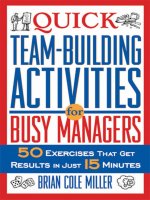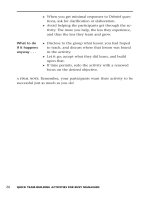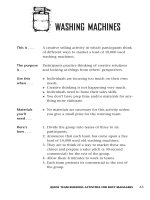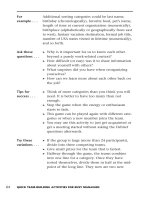50 activities for performance a wendy denham, jane jestico, eil
Bạn đang xem bản rút gọn của tài liệu. Xem và tải ngay bản đầy đủ của tài liệu tại đây (1.87 MB, 308 trang )
50 Activities for Performance
Appraisal Training
Wendy Denham
Jane Jestico
HRD Press, Inc. • Amherst • Massachusetts
Copyright © 1993, 2007 by Wendy Denham and Jane Jestico
The materials that appear in this book, other than those quoted from prior sources, may be
reproduced for educational/training activities. There is no requirement to obtain special
permission for such uses.
This permission statement is limited to reproduction of materials for educational or training
events. Systematic or large-scale reproduction or distribution—or inclusion of items in
publications for sale—may be carried out only with prior written permission from the publisher.
Published by:
HRD Press, Inc.
22 Amherst Road
Amherst, Massachusetts 01002
1-800-822-2801 (U.S. and Canada)
413-253-3488
413-253-3490 (fax)
www.hrdpress.com
ISBN 978-1-59996-052-Y
Production services by Jean Miller
Editorial services by Sally Farnham
Cover design by Eileen Klockars
Contents
Preface.....................................................................................................................................
Introduction ..............................................................................................................................
vii
Symbols ...................................................................................................................................
ix
Index to Activities by Skill.........................................................................................................
xi
Index to Activities by Process .................................................................................................. xiii
1.
2.
3.
4.
5.
6.
7.
8.
9.
10.
11.
12.
13.
14.
15.
16.
17.
18.
19.
20.
21.
22.
23.
24.
25.
26.
27.
28.
29.
30.
31.
32.
33.
34.
35.
36.
37.
38.
39.
Actions Speak Louder.......................................................................................................
An Appraisal Interview ......................................................................................................
Ask, and You Shall Receive..............................................................................................
The Beginning and the End ..............................................................................................
The BOFF Principle ..........................................................................................................
Both Sides of the Coin ......................................................................................................
Bull’s-eye! .........................................................................................................................
But That’s Not What I Meant.............................................................................................
But when have I got the time? ..........................................................................................
Choosing the Right Route.................................................................................................
Competition Time..............................................................................................................
Confirm It in Writing ..........................................................................................................
Discovering the Carrot ......................................................................................................
Do I appear neutral? .........................................................................................................
Do you really mean that? ..................................................................................................
Easy Listening...................................................................................................................
The evidence I shall give…...............................................................................................
For Better or Verse ...........................................................................................................
Good question!..................................................................................................................
How would you handle it? .................................................................................................
I Think I Have the Answer.................................................................................................
I think that’s what you said!...............................................................................................
In Summary.......................................................................................................................
It’s all experience! .............................................................................................................
Just Stick to the Facts.......................................................................................................
Keeping on Track..............................................................................................................
Let Me Explain ..................................................................................................................
The Motivation Minefield ...................................................................................................
My Learning ......................................................................................................................
Pathway to the Future.......................................................................................................
Perception of You and Me ................................................................................................
The Perfect System ..........................................................................................................
Picture This .......................................................................................................................
Piece by Piece ..................................................................................................................
Praise versus Criticism .....................................................................................................
A Question of Design ........................................................................................................
Ready, set, go!..................................................................................................................
The Right Person for the Job ............................................................................................
Sharpen your Targets .......................................................................................................
iii
1
5
13
23
29
41
45
55
61
69
77
81
91
97
101
107
111
115
119
129
139
141
143
153
157
159
167
169
175
179
185
189
193
195
199
207
215
219
227
50 Activities for Performance Appraisal Training
40.
41.
42.
43.
44.
45.
46.
47.
48.
49.
50.
The Silent Message ..........................................................................................................
So you know their job?......................................................................................................
That’s different! .................................................................................................................
To Let You Know ..............................................................................................................
Touch, Then Ask...............................................................................................................
We Always Listen..............................................................................................................
What do you think? ...........................................................................................................
What’s your view?.............................................................................................................
Where do I go from here? .................................................................................................
Why am I here?.................................................................................................................
Write or wrong!..................................................................................................................
iv
237
239
243
251
253
257
267
271
273
283
289
Preface
Over the years, our experience of managing and training individuals has proven to us the
benefits of participative and active learning. We believe that training can be enjoyable and
extremely motivating when conducted in this way, because it leads to a greater understanding
and a more powerful learning experience for each individual involved. When theories and
concepts are included as part of the training process, we always confirm participants’
understanding by giving them an opportunity to practice.
We feel very strongly that the subject of appraisal training is perceived by many people to be
uninteresting. We hope the activities in this manual will convince them otherwise.
We would like to express our thanks to all of those who have helped us throughout the
development of the activities. Our task has been made easier by their involvement and
enthusiasm.
Wendy Denham
Jane Jestico
v
Introduction
Maximizing the potential of every employee is the highest priority for many companies. More
and more companies have introduced an appraisal system in recent years, while others have
reviewed and improved their existing system, as they have identified the direct relationship
between the development of their employees and the success of the company. The rise in the
number of appraisal systems and their improved quality have not been matched with similar
changes in the field of appraisal training. The combination of these factors led the authors to
produce this manual.
The Activities
All the activities are participative, involving the participants in a variety of exercises. A choice of
practical tasks, case studies, graphics, questionnaires, and role plays is included. Some of the
activities include an explanation of a theory, followed by an opportunity to practice to confirm the
participants’ understanding. Others begin with the participants completing a task that is then
reviewed to consolidate the key learning points and principles.
For some people, appraisals are an extremely emotive subject. To allow for this, the content of
some activities is unconnected to the appraisals. Once the learning points have emerged from
the activity, they can be more easily related to the key elements within the appraisal process.
Sometimes the same subject might be approached in a variety of ways. For example, the
importance of using good questions during the appraisal process is demonstrated through a
competitive exercise, a case study, and the design of a questionnaire. This provides the trainer
with the flexibility to cater to most learning styles.
By slightly changing the emphasis of the activities, the content becomes suitable to all
categories of appraisers with different levels of experience. Most of the activities can be adapted
to groups of various sizes. A few of the exercises are useful for an appraiser to complete with
the appraisee. Some of the activities refer to the appraisal system of the participants’ company.
However, most of these can be applied to participants from different companies. The timing of
the activities will need to be adjusted accordingly.
The Location
Training should not always be confined to a formal training environment. When discussing
certain subjects, such as an appraisee’s performance, the activity can be conducted in the
workplace.
The Trainer
There is sufficient information within each activity to fully support the inexperienced trainer,
while providing stability for the most advanced trainer to adapt it to his or her own preferred
training style. In many cases, the participants would benefit considerably from their line
manager leading the activity.
vii
50 Activities for Performance Appraisal Training
The Materials
For ease of identification, all handouts for the participants are numbered using the same
number as the activity. For example, Activity 26: Keeping on Track includes Handouts 26.1,
26.2, and 26.3.
Where appropriate, it is suggested that some handouts be made into transparencies for use
with an overhead projector. In addition, some activities include overhead masters to be made
into transparencies.
To relate certain activities directly to the participants’ actual company appraisal system, the
trainer will need to collate information regarding that system before running the activity.
The Subject
Some activities can be linked to provide focused training on one subject area. Where
appropriate, this is mentioned within the activity.
To ease selection, the activities have been categorized using two types of matrix:
•
•
The skills
The process
There are six headings in the skills matrix:
•
•
•
•
•
•
Management
Listening
Questioning
Objectivity
Feedback
Communication
There are six headings in the process matrix:
•
•
•
•
•
•
Introduction to Appraisals
Preparation
Writing
The Interview—The Past
The Interview—The Future
Understanding the System
A Note on Terminology
The person administering the activities is referred to as the “trainer” and those at the receiving
end as the “participants.”
viii
Symbols
Handout
Transparency
ix
Communication
Feedback
Objectivity
Questioning
Listening
Activity Title
Management
Page No.
Activity No.
Index to Activities by Skill
1
Actions Speak Louder
1
•
2
An Appraisal Interview
5
•
3
Ask, and You Shall Receive
13
4
The Beginning and the End
23
5
The BOFF Principle
29
6
Both Sides of the Coin
41
7
Bull’s-eye!
45
•
8
But That’s Not What I Meant
55
•
9
But when have I got the time?
61
•
10
Choosing the Right Route
69
•
11
Competition Time
77
12
Confirm It in Writing
81
13
Discovering the Carrot
91
14
Do I appear neutral?
97
15
Do you really mean that?
101
16
Easy Listening
107
17
The evidence I shall give…
111
18
For Better or Verse
115
19
Good question!
119
20
How would you handle it?
129
21
I Think I Have the Answer
139
22
I think that’s what you said!
141
23
In Summary
143
24
It’s all experience!
153
xi
•
•
•
•
•
•
•
•
•
•
•
•
•
•
•
•
•
•
•
•
•
•
•
•
•
•
•
Communication
Feedback
Objectivity
Questioning
Listening
Activity Title
Management
Page No.
Activity No.
50 Activities for Performance Appraisal Training
•
25
Just Stick to the Facts
157
26
Keeping on Track
159
27
Let Me Explain
167
28
The Motivation Minefield
169
29
My Learning
175
30
Pathway to the Future
179
31
Perception of You and Me
185
32
The Perfect System
189
•
33
Picture This
193
•
34
Piece by Piece
195
35
Praise versus Criticism
199
36
A Question of Design
207
37
Ready, Set, Go!
215
38
The Right Person for the Job
219
39
Sharpen your Targets
227
40
The Silent Message
237
41
So you know their job?
239
42
That’s different!
243
43
To Let You Know
251
44
Touch, Then Ask
253
•
45
We Always Listen
257
•
46
What do you think?
267
47
What’s your view?
271
•
48
Where do I go from here?
273
•
49
Why am I here?
283
•
50
Write or wrong!
289
•
xii
•
•
•
•
•
•
•
•
•
•
•
•
•
•
•
•
•
•
•
•
•
•
•
•
•
1
Actions Speak Louder
1
2
An Appraisal Interview
5
3
Ask, and You Shall Receive
13
4
The Beginning and the End
23
•
5
The BOFF Principle
29
•
6
Both Sides of the Coin
41
7
Bull’s-eye!
45
8
But That’s Not What I Meant
55
9
But when have I got the time?
61
10
Choosing the Right Route
69
11
Competition Time
77
12
Confirm It in Writing
81
13
Discovering the Carrot
91
14
Do I appear neutral?
97
15
Do you really mean that?
101
16
Easy Listening
107
17
The evidence I shall give…
111
•
18
For Better or Verse
115
•
19
Good question!
119
•
•
20
How would you handle it?
129
•
•
21
I Think I Have the Answer
139
22
I think that’s what you said!
141
•
•
23
In Summary
143
•
•
24
It’s all experience!
153
•
•
xiii
Understanding
the System
The Interview
The Future
The Interview
The Past
Writing
Preparation
Activity Title
Introduction to
Appraisals
Page No.
Activity No.
Index to Activities by Process
•
•
•
•
•
•
•
•
•
•
•
•
•
•
•
•
•
•
•
•
•
•
•
•
25
Just Stick to the Facts
157
26
Keeping on Track
159
27
Let Me Explain
167
28
The Motivation Minefield
169
29
My Learning
175
30
Pathway to the Future
179
•
•
31
Perception of You and Me
185
•
•
32
The Perfect System
189
33
Picture This
193
34
Piece by Piece
195
•
•
35
Praise versus Criticism
199
•
•
36
A Question of Design
207
•
37
Ready, Set, Go!
215
•
38
The Right Person for the Job
219
39
Sharpen your Targets
227
40
The Silent Message
237
41
So you know their job?
239
42
That’s different!
243
43
To Let You Know
251
44
Touch, Then Ask
253
•
•
45
We Always Listen
257
•
•
46
What do you think?
267
47
What’s your view?
271
48
Where do I go from here?
273
49
Why am I here?
283
50
Write or wrong!
289
xiv
Understanding
the System
The Interview
The Future
The Interview
The Past
Writing
Preparation
Activity Title
Introduction to
Appraisals
Page No.
Activity No.
50 Activities for Performance Appraisal Training
•
•
•
•
•
•
•
•
•
•
•
•
•
•
•
•
•
•
•
•
•
•
•
•
•
•
1
Actions Speak Louder
DESCRIPTION
This activity is based on participants reading a series of statements and
deciding which statements apply to whom. This leads to a discussion on
how quickly people make judgments about one another, how accurate these
judgments are, and the effect of these judgments during the appraisal
process.
SITUATIONS
This group activity can be used when covering the topic of stereotyping and
objectivity. It is most effective with individuals who have not met before or
who know only a little about one another. It can be used as an icebreaker. It
is an exercise that can stimulate a great deal of discussion.
OBJECTIVES
•
•
•
TIME
MATERIALS
REQUIRED
METHOD
To highlight how participants stereotype and make judgments
To examine the accuracy of these judgments
To examine the effect of stereotyping on the appraisal process
40 minutes
•
•
•
Flipchart and markers
Handout 1.1
Name badges
1. Before the start of the activity, write each of the suggested statements
from Handout 1.1 on separate pieces of flipchart paper. Hang each piece
of paper on the wall around the room.
2. Give every participant a name badge. At this stage of the activity, do not
state the objectives of the exercise.
3. Distribute Handout 1.1 and ask everyone to consider individually which
statement applies to whom. Allow a few minutes for consideration.
4. Ask everyone to write the names of the participants to whom each
statement applies on the appropriate piece of paper on the wall.
Individuals can write more than one name under each statement.
5. Review the activity by asking the group to comment on how they reached
their decisions. Ask why some participants felt that a particular statement
applied to certain individuals and others felt that the same statement did
not apply. Ask the group if the statements made about them were
accurate.
1
50 Activities for Performance Appraisal Training
6. Explain the factors that contribute to why people stereotype one another.
Ensure that the following points are covered:
•
•
•
•
Past experiences
Personal values
Beliefs
Prejudices and biases
7. Ask the group to comment on the effect stereotyping can have on the
appraisal process. List answers on the flipchart, including points such as:
•
•
•
•
•
•
Lack of trust in the appraisal system
Unfair appraisals
Less effective team
Unmotivated team
Pay and promotional restrictions
Poor selection of individuals for new opportunities
8. Conclude the session by asking the group to consider the steps that can
be taken to avoid stereotyping. Ensure that the following suggestions are
discussed:
•
•
•
•
Be continually aware of personal prejudices, values, and beliefs.
Base all decisions on factual evidence.
Keep an open mind. Never assume you know the answer before you
have asked the individual the question.
Allocate ample time to communicate with your team.
2
Handout 1.1
Statements
•
These people hold left-wing views.
•
These people play a musical instrument.
•
These people drive a sports car.
•
These people are vegetarians.
•
These people own a dog.
•
These people are introverts.
•
These people have children.
•
These people are successful.
Reproduced from 50 Activities for Performance Appraisal Training
Wendy Denham and Jane Jestico, HRD Press, Inc.
2
An Appraisal Interview
DESCRIPTION
This activity centers on a role play and participant feedback to give
participants practice providing critical feedback. In groups of three,
participants have the opportunity to practice conducting an appraisal
interview using a prepared scenario. The interview focuses on dealing with
an employee who is performing just below the company requirements.
Within every group, there is an opportunity for each participant to be the
interviewer, interviewee, and the observer. The observer leads the
discussion after the interview and gives feedback to the interviewer.
SITUATIONS
This is an ideal exercise to follow Activity 5: The BOFF Principle.
Alternatively, it can be used as an activity to provide more practical
experience to those who have difficulty dealing with poorly performing
employees. The skills needed to give critical feedback are not just confined
to appraisal interviews, and therefore the activity could be used for all line
managers who need to use the skills in everyday work situations.
OBJECTIVES
•
•
•
TIME
MATERIALS
REQUIRED
METHOD
To practice giving verbal critical feedback
To discuss this key skill of giving feedback when employees are
underperforming
To give the participants the chance to receive feedback on their
performance as an appraiser in an interview situation
60 minutes
•
•
Flipchart and markers
Handouts 2.1, 2.2, and 2.3
1. Describe the activity about to take place, emphasizing that the role play
will provide an opportunity for participants to practice skills in the
particular area of giving critical feedback within an appraisal interview.
2. Split the group into teams of three and distribute Handouts 2.1 and 2.2.
Explain that the interviewee should use the role play scenario as a guide,
then react naturally to the interviewer’s questions and behavior. If he
genuinely has feelings about the way the interview is being handled, he
should react accordingly.
3. Encourage the observers to use Handout 2.3, the review sheet, to help
them lead the discussion after the interview.
4. Check everyone’s understanding of the role play by inviting questions.
Inform the group that they have 5 to 10 minutes for each interview, with 5
minutes for discussion. After each round, they should change places so
that everyone has a turn at each role.
5
50 Activities for Performance Appraisal Training
5. Start the role plays and monitor timing carefully. When participants have
finished, the teams should re-assemble.
6. Encourage a debate on one or two of the following questions:
•
•
•
Why is it so difficult to give critical feedback, especially within
appraisal interviews?
On what occasions might an appraiser have to give negative
feedback?
What experiences have participants had giving critical feedback and
what did they learn from those experiences?
7. Emphasize that one of the key techniques for giving feedback is to
provide specific examples of the person’s actions. This increases the
objectivity of the feedback and lessens judgmental opinions. It also
makes the feedback very difficult to refute. If the result of the person’s
actions is also mentioned, this makes the feedback even more powerful.
8. End the session by reminding the group that one of the essential skills in
being an appraiser and a manager of people is to be able to give both
positive and negative feedback in an assertive manner so that the
message is clear and firm. People learn from the criticism they receive
as well as the praise, often more so from the former. It can be said that
critical feedback tells people if they are on target. The worst thing people
can do is to do the same wrong things again and again. People need to
know what they are doing and what the impact is. They have to learn to
take feedback in order to grow, change, and develop.
6
Handout 2.1
Role Play—Employee’s Role
You are Mary who works in the customer service department for the large insurance company
Nextime. Your job is to answer the telephone promptly and to handle all customer questions
arising from these calls. You can deal with some of the calls yourself, but others have to be
passed on to the specialist departments. You are also expected to write letters to customers
based on conversations that you have had with them. You work within a team of four, reporting
to James, the supervisor. You get along well with the other team members and enjoy their
company. You cover for each other during breaks and vacations.
You have worked for the company for about two years and are starting to feel a bit bored with
the job. You know you are typically good with the customers and pass on the questions to other
departments politely. In spite of this, you know you have been making more mistakes on your
letters, although you could not quantify the actual number. Jane, the administrative assistant,
has jokingly mentioned the increase in these mistakes, and you have promised her that you will
try to improve. The way you answer the phone has not changed, at least no one has told you
that it has, and you are not aware of any customer complaints about you. It is appraisal
interview time, and you are feeling apprehensive. James has been so busy lately that you have
had little opportunity to communicate with him. You are therefore not sure how aware he is of
the mistakes you have been making; with luck, they could have escaped his attention. However,
he will definitely discuss the times when he has had to question some of the information you
have sent out to customers. Still, you believe you are better than the others in the team, so you
are confident that these small mistakes will not be discussed.
Reproduced from 50 Activities for Performance Appraisal Training
Wendy Denham and Jane Jestico, HRD Press, Inc.
Handout 2.2
Role Play—Appraiser’s Role
You are James, the supervisor of a team of four in the customer service department of the large
insurance company Nextime. The job of the customer service department is to answer the
telephone promptly and to handle all customer questions arising from these calls. The team can
deal with some of the calls, but others have to be passed on to the specialist departments. The
team also writes to the customers to whom they have spoken, confirming their telephone call.
You are about to conduct the appraisal interview with Mary, a member of your staff. Mary has
been working in the team for about two years, and for the first 18 months, her work was
impressive: She has been accurate in her written communication, pleasant and polite to the
customers, and enthusiastic in her approach to all aspects of her work. However, within the past
six months, some of these standards have been slipping; in particular, she takes longer than the
allowed time for breaks, the standard of letter writing has dropped, and her tone of voice when
she first picks up the telephone is abrupt.
With regard to her meal breaks, on at least three occasions within the past month, she has
taken longer than the one hour allowed for lunch. You cannot remember the actual days when
this occurred, although you do recall it caused others in the team to be late in going to lunch and
therefore annoyed them. On two of these occasions, Mary knew you were displeased by the
look you gave her.
You have been meaning to speak to Mary about the fall in the standard of letters she has emailed to Jane, the administrative assistant, to finalize and send out. Time has been so tight
that you have not spoken to Mary, and you know it will be an issue in this interview. Standards
such as spelling and organization started falling about four months ago, causing Jane to actually
complain to you. In addition to this, you have had to take calls from customers who have
needed to have the information in letters they have received from Mary clarified.
The third example of falling standards is in Mary’s tone of voice when she picks up the phone.
You personally have heard her on two occasions: The first time it happened, Mary was on her
way to lunch when she picked up the phone and simply said, “Yes” in an offhand manner. She
soon changed her tone and the call seemed to go well. On the second occasion, she said,
“Well?” to the customer in a blunt tone. Once again, this was rectified and the rest of the call
seemed to pass smoothly.
You will use the appraisal interview to raise these issues.
Reproduced from 50 Activities for Performance Appraisal Training
Wendy Denham and Jane Jestico, HRD Press, Inc.
Handout 2.3
The Review Sheet—For Observers
Watch the interchange between the appraiser and appraisee, although the main focus of
attention should be on the appraiser. Be aware of the questions asked, how the feedback is
given, and how the responses of the appraisee are handled.
You will be giving feedback to the appraiser and leading the review after the role play. In order
to do this, record below what actually happened or was said so that you can be very specific in
your comments and provide examples.
1. What questions were asked?
2. How were the critical issues raised?
3. How were the responses of the appraisee handled?
4. How successful was the appraiser in making the appraisee aware of the critical areas?
5. What mood did the appraisee appear to be in during and at the end of the interview?
Reproduced from 50 Activities for Performance Appraisal Training
Wendy Denham and Jane Jestico, HRD Press, Inc.









